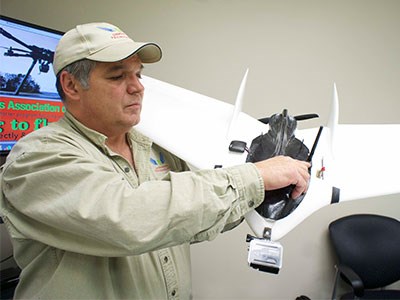Precision agriculture is a part of the new vernacular in farming.
One fledgling northeastern Ontario drone company is on the flightpath to make a landing in that market.
Although Ray Belec of Unmanned Technology is certified to fly UAVs (unmanned aerial vehicles) anywhere in Canada, he finds there is an abundance of opportunity in his own backyard.
“We’ve kind of positioned ourselves in a really good place,” said the Kirkland Lake-born, New Liskeard-raised Belec.
The multi-faceted company that he and his wife, Nicole, launched last June offers a wide range of aerial and training services for an expanding list of clients.
The couple maintains a Kirkland Lake home but spends most of their time at their CNC-equipped development centre in Restoule, southwest of North Bay. There, on 180 acres of farmland, Belec manufactures his own fibreglass and aluminium airframes and tests the drones’ flight and payload systems in Transport Canada-secured airspace.
Rather than work in a silo, Belec has taken a more collegial approach to business by forming a consortium with other UAV companies, incorporating their individual specialities, to collaborate on larger projects and help each other source work.
Last summer, Belec joined forces with North Country Aerial on a joint mapping project of the town of Cobalt. The data gathered is being 3D printed into a scale model at Canadore College’s ICAMP technology campus in North Bay.
He also assists other UAV companies in wading through the paperwork of meeting Transport Canada and Industry Canada regulatory compliance. Since no federal UAV pilot certification program currently exists, Belec developed his own program that’s been sanctioned by Transport Canada. So far, he’s trained 10 operators from the five partner companies he works with.
“We found that by helping other companies get their compliances that it really opened the door to doing these joint ventures.”
Trained as a CNC programmer, Belec spent seven years at sea as a Canadian Armed Forces marine engineer before going to work for Davie Shipbuilding in Quebec where he worked on the navy’s frigate program.
Drones aren’t just airborne platforms, explained Belec. The new class of Canadian warships can take to sea, virtually unmanned, and be operated from a land base via satellite. Whereas these complex and sophisticated vessels have 80,000 control points, a UAV has only six.
“What I realized is that it’s not a huge step from (CNC and computer) programming to drone programming.”
In his arsenal, Belec has an array of lightweight and mid-sized cameras for a quadcopter, an octocopter and a large fixed-wing craft.
He initially hoped to find contract work in the mining and forestry industries, but surprisingly discovered that farmers in the Temiskaming area were more attuned to the capabilities of this technology after attending a Grain Farmers of Ontario meeting in January.
“I was really impressed with how knowledgeable farmers are with the drone industry.”
The new trend in precision agriculture involves using UAVs as an aerial survey, delivery, data and image-gathering platform. Precision ag is basically the use of high-tech science and gadgetry to maximize the use of farmland.
The Clay Belt in northeastern Ontario is fast becoming a rich environment for Belec to deploy his cool and agile machines.
During key times of the year, farmers want to employ drones like mini crop-dusters for pesticide spraying, for dropping fertilizer pellets between rows of potatoes, and to send them aloft early in the growing season to check for voids in their fields.
“We’re getting quite a backlog of jobs lined up for once the season hits again,” said Belec.
He’s sold one fixed-wing drone to one farmer and provides aerial services to others.
“Farmers are fiercely protective and a lot of them like to have the technology themselves. For the rest, we go out and fly their crops for them,” he said.
Municipalities are equally up to speed in using drones for GIS applications.
Kirkland Lake, Restoule and Ottawa have allowed him access to provide volume metrics on their landfills. A potential new wave of work may come on the bylaw enforcement side in checking on property owners who may be illegally building without permits. Municipalities view these fines as a source of new revenue.
Belec has flown for camp operators who want to track wildlife movement in order to position their hunting blinds, and a wind energy company contracted him to pinpoint locations to deploy wind turbines.
One company has approached him to do remote mapping in the Ring of Fire and a First Nation has expressed interest in surveying the work that mining contractors are doing on their traditional lands.
For down the road, Belec is working on a joint project on a fully autonomous UAV that local municipalities want for airports to keep moose and wildlife off the runway. Through the touch screen on a tablet in the control tower, the craft would be activated to scare the animals away.




